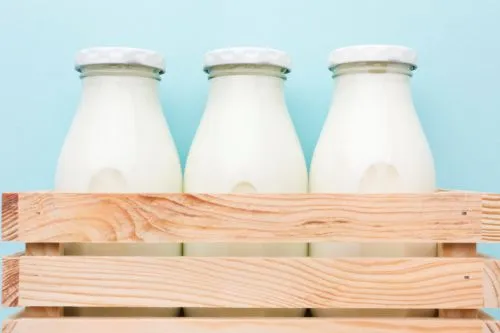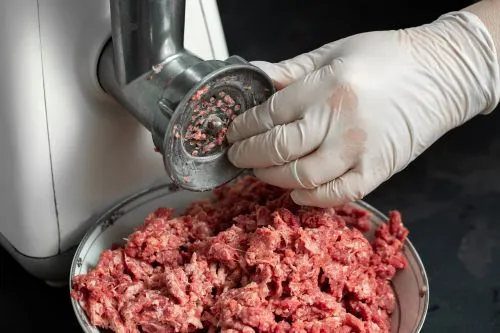
In conditions where more and more farmers are opting for the installation of automated milking systems, attention should be paid to whether cows have enough time to consume sufficient levels of concentrate during milking, DairyGlobal reports.
A study
Since cows spend less time being milked during each visit to the robot, it might be assumed that they do not consume enough concentrate for maintenance and production. To counteract this issue, some farmers install feeders outside the milking parlor to allow for additional concentrate intake, but could these have a negative impact on robot visit frequencies?
This is exactly what a study in Northern Ireland aimed to address, undertaken by AFBI. AFBI examined the benefits of robotic systems and how different feeding systems affected milking, yield, and concentrate usage.
One of the fundamental aspects of the study focused on the hypothesis that when farmers, especially in Northern Ireland, transition to an automatic milking system, they usually move to a year-round calving model. This move results in varied energy requirements within the herd, and meeting these varied needs of individual cows through a partial mixed ration (PMR) is often very challenging.
Therefore, it's necessary to provide cows with high energy requirements (usually at the beginning of lactation and for high yielding cows) with additional concentrate. Typically, this is done at the milking robot feeding station or through feeders outside the parlor.
Concentrate consumption
Within automated milking systems, the feeder seems like the natural choice to feed cow concentrates. However, the amount of concentrate a cow is able to consume is limited by her milking frequency, milking time, and eating rate.
All of these factors can lead to cows simply not having enough time in the milking robot to consume an adequate amount of concentrates. Feeders outside the parlor have been suggested as a useful source of additional concentrate for automated milking systems.
However, since providing concentrated feed within the robot is used to motivate cows to be milked, it's important to understand whether feeding extra concentrate outside the parlor would have a negative impact on robot visit frequency or not.
Study details
For this study, AFBI housed 48 cows using 1 milking robot and 2 feeders outside the parlor. A PMR containing 80% grass silage and 20% whole crop, plus 2 kg concentrate mix per cow, was fed once daily.
The cows were divided into 2 different groups and fed differently to evaluate their activity. The first group, "robot high" cows, received 80% of their supplementary concentrate ration at the milking robot feeding station and 20% through feeders outside the parlor.
The second group, "robot low" cows, received 20% of the supplementary concentrate at the milking robot feeding station and 80% through feeders outside the parlor. These additional concentrate amounts were provided on a yield basis, but a minimum of 1 kg per cow per day was always provided through the milking robot feeding station.
With staff recording PMR and concentrate intake per cow, the study explored the effects of concentrate allocation on visits to the milking robot and feeders outside the parlor, concentrate intake and PMR, milk production, and lying time.
Study outcome
There were no differences between groups in terms of successful milking visit numbers, unsuccessful milking visits (when a cow returns to the robot too soon after the previous visit and is not milked), or lying time. However, visit rates to the feeders outside the parlor differed, as "robot high" cows visited the feeders an average of 8.01 times less per week than "robot low" cows.
"Robot high" cows had particularly low feeder visit frequencies outside the parlor in week 4, with nearly half the number of visits as "robot low" cows. "Robot low" cows consumed more of their daily concentrate ration, a combination of the milking robot feeding station and feeders outside the parlor, leaving on average 192.5 g compared to "robot high" cows leaving an average of 379 g.
"Robot high" cows consumed an average of 46.3 kg of PMR, while "robot low" cows consumed an average of 49.4 kg. However, "robot high" cows consumed less PMR than "robot low" cows only in week 1, after which there were no differences in PMR intake between treatments. There were also no differences in milk production between treatments.
Conclusions
The study found that milking frequency was not affected when cows were offered the majority of their concentrate ration at feeders outside the parlor. Accordingly, yield was not affected by where most concentrates were provided.
Additionally, cows that received the majority of their concentrate at the milking robot did not exhibit a higher number of unsuccessful milking visits. Thus, it was unsurprising that there was no effect on lying time.
Interestingly, cows with a greater allocation at feeders outside the parlor visited them more frequently, meaning cows can adjust their visits as necessary to meet their energy requirements.
Though milk production was maintained regardless of feed allocation patterns, cows with higher allocations at the milking robot left larger amounts of concentrate unconsumed, which is an area of concern.
This further confirms that consumption of very high levels of concentrate in the milking robot is limited by the time available during milking. Many cows may not have enough time during milking to consume their full feed ration.
Regarding PMR intake, cows provided with more concentrate at the milking robot had lower PMR intakes in week 1 than those provided with more concentrate at feeders outside the parlor, but the effects did not persist beyond week 1.
Key Takeaways
Providing concentrates to cows away from the milking robot has no adverse effects on robot visits, yields, or lying time.
However, providing more feed outside the milking robot reduced the amount of unconsumed concentrate, which would have a beneficial effect on farm efficiency.
Farmers should ensure that cows are not over-allocated concentrated feed at the milking robot. (Photo: Freepik)




